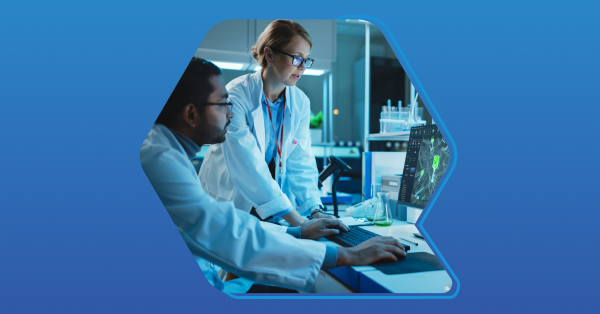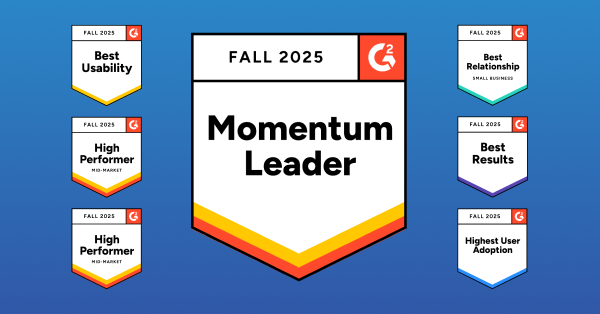Transforming Genomics Labs: How a LIMS Addresses Industry Challenges

Is your genomics lab overwhelmed by the sheer volume of data and stringent FDA regulations? You're not alone.
In October 1990, what started as a dream to map the entire human genome, advance medicine, and usher in a new era kicked off a 10+ year project and $1B investment. Fast-forward to the 2020s and the human genome can be mapped for $1,000 - that’s not a bad reduction in price after 30 years of innovation.
With such a reduction in price and time, medical discoveries abound as we gain a deeper understanding of what makes humanity tick. This is not entirely altruistic; In 2023, experts valued the global genomics market at $32.65 billion USD, and they forecast it to reach $94.86 billion USD by 2030. In an industry where a single genome sequence generates terabytes of data, effective information management systems are no longer a luxury—they're a necessity.
In this article, we’ll dive into the unique challenges genomics labs face and how a LIMS helps them overcome them.
Top Challenges Genomic Labs Face
Genomics labs can expect to run into some of the same challenges that all labs suffer from regarding data management and sample management at scale. These challenges uniquely affect genomics labs in a few key ways, which we’ll uncover.
The key challenges that genomics labs face are:
- Sample management
- Data management and ever-changing analysis methods
- Data sharing and collaboration
- Integration with third-party systems
- Compliance and regulatory requirements
- Rapid industry change
- Increasing demand for personalized medicine
As genomics labs strive to advance personalized medicine, they encounter unique challenges that go beyond standard data and sample management issues. The need to process and analyze vast amounts of individual genetic data to develop tailored therapies intensifies the demands on lab infrastructure and data systems.
Genomics labs must keep pace with rapid industry advancements. New sequencing technologies, evolving data analysis methods, and shifting regulatory requirements mean that labs need systems capable of adapting quickly to change.
Sample Management
Sample management is one of the biggest challenges for any lab - especially labs managing samples at scale. Inefficient sample management can lead to sample degradation, loss, or misidentification, potentially costing labs thousands of dollars and compromising testing integrity. Sample management covers:
- Storage
- Maintaining quality
- Monitoring usage
- Defining aliquots for sequencing
Smaller labs may get by managing everything manually. However, for larger labs, relying on outdated methods like spreadsheets or pen and paper is a recipe for disaster. Not only is it cumbersome and time-consuming, but it quickly leads to data entry errors as well.
For genomics labs, each sample represents a unique patient's genetic profile and any mismanagement can lead to incorrect diagnoses or treatments. Robust sample management systems are essential to support personalized therapeutic approaches.
Data Management and Analysis
It’s estimated that NGS (next generation) genome sequencing would hit 60 petabytes of data processed by 2023 (for reference, a single whole-genome sequencing run generating 2.5 terabytes).
In layman’s terms, that is a serious amount of data. This throughput adds yet another strain on labs as they try to manage, analyze, and make decisions based on their data.
The analysis costs remain high despite the lowering of sequencing costs. The “store everything” approach becomes the biggest bottleneck to analysis for the sequencing lab. Therefore, substantial manual effort is required to find the critical data for the analysis.
Personalized medicine amplifies data management challenges, as labs must handle not just large volumes but also highly individualized datasets. Advanced analytics are required to interpret genetic variations and translate them into actionable medical insights, necessitating powerful data management and analysis solutions within a LIMS.
Data Sharing and Collaboration
Beyond managing data, sharing it and collaborating on it presents a massive challenge for labs at this scale.
As illustrated above, genomic data for a single sample can reach terabyte sizes, leading to data silos in labs as vast amounts of data are generated for multiple samples. This makes collaboration and data sharing with global teams a significant challenge.
Effective personalized medicine relies on seamless collaboration between labs, clinicians, and researchers. Sharing sensitive patient genetic data securely and efficiently is crucial, yet challenging given the data sizes and privacy concerns involved.
Integration With Other Systems
As the focus is on multi-omics, most laboratories integrate their genomics data with other omics data, such as transcriptomics, epigenomics, metabolomics, and proteomics. The integration of genomics data and NGS instruments with other systems is still a challenge for many laboratories.
Compliance and Regulatory Requirements
Compliance can be a challenge for labs across industries. Magnify that by a factor of 100 at the level of scale and oversight by the FDA for genomics labs.
With personalized medicine, protecting patient-specific genetic information becomes even more critical. Labs must comply with stringent regulations like HIPAA to safeguard privacy and maintain trust, adding another layer to compliance efforts.
Many laboratories and genetic testing facilities face the challenge of complying with legal standards and maintaining detailed audit trails. FDA regulations such as 21 CFR Part 11 require strict compliance for:
- Auditing data
- Proper storage of data and samples
- Regular data backups
- Training of staff
And more.
These challenges can be enough to give your lab pause, but there’s a way to overcome them: a LIMS. We’ll explore how a LIMS can benefit your genomics lab next.

How LIMS Addresses the Challenges in the Genomics Industry
A LIMS (Laboratory Information Management System) is a platform designed to manage data at scale, automate workflows, monitor samples, and more.
A LIMS provides a structured, organized, and compliant platform that helps manage the data generated in genomics. A LIMS can serve your lab in the following ways:
- Automate workflows
- Data management
- Data analysis
- Data sharing and collaboration
- Quality control and compliance
- Inventory management
- Instrument integration
Automate Lab Workflows
Many LIMS boast robust automation capabilities to speed up processes for your lab. From automated workflows for sample registration and tracking to analysis and other key NGS actions, your staff can spend more time doing important work rather than busy work.
These templates can be designed for most NGS application scenarios and enable your scientists to quickly and effectively utilize your technology and achieve the desired results. QBench's pre-built workflow system ensures sample traceability, standardizes best laboratory practices, and ensures that scientists always work on high-priority tasks.
It’s important to note, however, that not all automation engines are the same. Many legacy LIMS offer custom-coded solutions which will incur high development costs as you need to make adjustments. QBench offers a no-code configurable solution for automation, allowing you to quickly adjust workflows as your lab’s needs change.
Data Management
Recall the data management challenges from before. A LIMS centralizes and organizes genomic data based on individual sample information, ensuring seamless and easy retrieval of critical information with a single click.
With its cloud-based software, a LIMS like QBench allows your global team better access to data and guarantees data integrity.
Data Analysis
Rather than fuss with charts and visualizations in Excel, a LIMS can help you analyze data at scale with robust reporting dashboards and integrations with popular BI tools.
This reduces analysis costs by storing data sequentially, allowing your bioinformaticians to access them quickly. It also stores critical information such as run quality metrics (%PF, first cycle, intensity, cluster density, etc.), the base calling algorithm, demultiplexed reads, and sequencing data, which fastens the analysis process.
Furthermore, a LIMS’ data traceability features make data analysis easier and simpler.
Data Sharing and Collaboration
As remote and distributed teams become the norm, it’s more important than ever to provide a secure way for your staff to access critical data. A cloud-based LIMS makes it trivial to offer secure access to your staff, no matter where they are located. They can also access real-time data, annotate findings, and contribute to collaborative projects without data silos.
Quality Control and Compliance
Compliance is nearly impossible to effectively manage at scale with manual methods, but a LIMS can be a significant asset for your lab to:
- Monitor the quality of starting material for NGS and sample purity.
- Checks the yields per run, the Q score, the error rate, and the cluster passing filter in the Illumina sequencing run.
- Check reading lengths, GC content, adapter content, and duplication to ensure data quality.
These automated quality control checks and validations guarantee the accuracy and consistency of the data and increase the reliability of the research results.
When it comes to data integrity and regulatory compliance, a LIMS like QBench records and time-stamps all user actions, including the addition, modification, and deletion of data. If your LIMS has a highly integrated quality management system (QMS), it ensures that all critical documentation and audit trails are always available for regulatory inspections.
With a LIMS, laboratories can effectively meet the requirements of FDA 21 CFR Part 11 and ISO/IEC 17025.
Inventory Management
As we discussed, these scaling challenges for labs can make inventory management a nightmare if you rely on a notebook or Excel spreadsheet.
Fortunately, a LIMS is a major asset for tracking usage, expiration dates, and more. This allows your lab to have an accurate read on which lots are running low or expiring to help your lab prevent slowdowns and quality control issues that can compromise test results.
Seamless Multi-Omics Integration
Thanks to API support and native integrations, a LIMS can connect with third-party systems and instruments to bring all your lab’s data into one central repository. This enables seamless system integration and data from different omics, such as transcriptomics, proteomics, and metabolomics.
As personalized medicine advances, the integration of genomics data with other omics data—such as transcriptomics (RNA expression profiles), proteomics (protein expression and modifications), and metabolomics (metabolic profiles)—becomes increasingly essential.
The holistic approach of personalized medicine combines diverse datasets to provide tailored treatments based on a comprehensive understanding of an individual’s biological makeup. For example, a single patient analysis might require integrating whole genome sequencing data from a DNA sequencing instrument, RNA sequencing data from a different instrument, and mass spectrometry-based proteomics data, each with its own data format and analysis pipeline.
A flexible LIMS (like QBench, with a robust and RESTful API ) facilitates seamless integration with various systems and instruments, enabling your lab to combine multiple data sources efficiently.

Which LIMS is the Best Option for Genomics Labs?
Of all the LIMS available, which should you choose for your lab?
We’d recommend QBench.
According to G2’s Top LIMS Rankings, QBench is the best LIMS in North America in 2024. QBench is flexible enough to adapt to your unique NGS workflows and automate your genomics lab to eliminate laborious manual processes and outdated, cumbersome systems.
Among its top features, QBench boasts:
- No-code configurable workflows
- A built-in, tightly integrated QMS
- Integrations with 50+ popular software tools
- Excellent support
- HIPAA compliance
- Support for 21 CFR Part 11
QBench stands out with its unparalleled flexibility and robust API, crucial features for labs in the fast-paced genomics industry. Its no-code configurable workflows mean you can adjust processes, integrate new instruments, and adapt to regulatory changes swiftly. QBench laps the competition on the pace of product improvement by releasing product updates every three weeks, many of which are filled with new features that customers requested. When you choose QBench, you're not just choosing a LIMS but a partnership that will grow with your lab. Keep your lab at the forefront of innovation by partnering with QBench.
Need Help in How to Tackle the Challenges in Genomics Research? Check Out QBench Today
With the pace only getting faster for genomics labs, it’s more important than ever to leverage software like a LIMS to manage data, automate processes, and meet compliance requirements.
If you’re looking for a flexible, user-friendly LIMS that your lab can implement quickly and adapt as your needs change, then we’d recommend QBench. Click the button below to schedule a demo of QBench and see how it can help your genomics lab.








